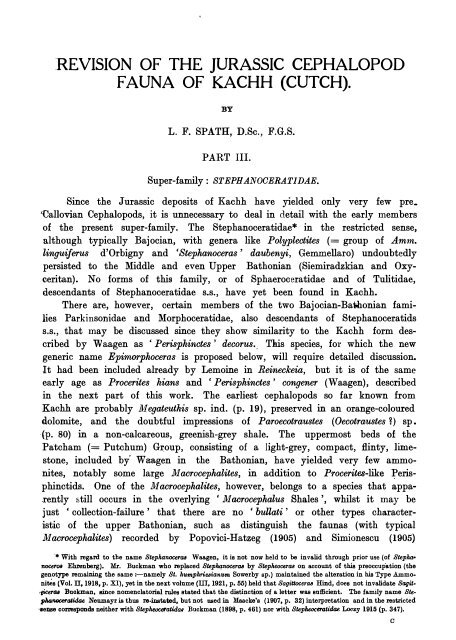ialontolngia ndita,
ialontolngia ndita,
ialontolngia ndita,
You also want an ePaper? Increase the reach of your titles
YUMPU automatically turns print PDFs into web optimized ePapers that Google loves.
REVISION OF THE JURASSIC CEPHALOPOD<br />
FAUNA OF KACHH (CUTCH).<br />
BY<br />
L. F. SPATH, D.Sc., F.G.S.<br />
PART Ill.<br />
Super-family: STEPHANOCERATIDAE.<br />
Since the Jurassic deposits of Kachh have yielded only very few pre.<br />
'Callovian Cephalopods, it is unnecessary to deal in detail with the early members<br />
of the present super-family. The Stephanoceratidae* in the restricted sense,<br />
although typically Bajocian, with genera like Polyplectites ( = group of Amm.<br />
linguiferus d'Orbigny and 'Stephanoceras' daubenyi, Gemmellaro) undoubtedly<br />
persisted to the Middle and even Upper Bathonian (Siemiradzkian and Oxyceritan).<br />
No forms of this family, or of Sphaeroceratidae and of Tulitidae,<br />
descendants of Stephanoceratidae s.s., have yet been found in Kachh.<br />
There are, however, certain members of the two Bajocian-Balhonian families<br />
Parkinsonidae and Morphoceratidae, also descendants of Stephanoceratids<br />
s.s., that may be discussed since they show similarity to the Kachh form described<br />
by Waagen as 'Perisphinctes' decorus._ This species, for which the new<br />
generic name Epimorphoceras is proposed below, will require detailed discussion.<br />
It had been included already by Lemoine in Reineckeia, but it is of the same<br />
early age as Procerites hians and 'Perisphinctes' congener (Waagen), described<br />
in the next part of this work. The earliest cephalopods so far known from<br />
Kachh are probably il1egateuthis sp. ind. (p. 19), preserved in an orange-coloured<br />
dolomite, and the doubtful impressions of Paroecotraustes ( Oecotraustes 1) sp .<br />
(p. 80) in a non-calcareous, greenish-grey shale. The uppermost beds of the<br />
Patcham (= Putchum) G:roup, consisting of a light-grey, compact, flinty, limestone,<br />
included by' Waagen in the Bathonian, have yielded very few ammonites,<br />
notably some large Macrocephalites, in addition to Procerites-like Perisphinctids.<br />
One of the Macrocephalites, however, belongs to a species that apparently<br />
till occurs in the overlying 'Macrocephalus Shales', whilst it may be<br />
just 'collection-failure' that there are no 'bullati' or other types characteristic<br />
of the upper Bathonian, such as distinguish the faunas (with typical<br />
Macrocephalites) recorded by Popovici-Hatzeg (1905) and Simionescu (1905)<br />
··With regard to the name 8tepha1WCeras Waagen, it is not now held to be invalid through prior use (of Stephao<br />
1WCeroa Ehrenberg). Mr. Buckman who replaced 8tepha1WCeras by Stepheoceras on account of this preoccupation (the<br />
genotype remaining the same :-namely St. humphrie.Bianum Sower by sp.) maintained the alteration in his Type Ammonites<br />
(Vol. IT, 1918, p. XI), yet in the next volume (III, 1921, p. 55) held that Sagittoceras Hind, does not invalidate 8agit<br />
•Pcera8 Buokman, aince nomenclatorial rules stated that the distinction of a letter was sufficient. The family name StepliG'MJCef'atidae<br />
Neumayr is thus re-instated, but not used in Mascke's ( 1907, p. 32) interpretation and in the restricted<br />
-.ense corresponds neither with Stephwceratidru Buckman (1898, p. 461) nor ·Kith Stepheoceratida.e Loozy 1915 (p. 347).<br />
c
















